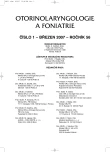Quality of Life in Patients with Tracheostomy
Authors:
I. Čiháková; P. Čelakovský
Authors‘ workplace:
Ušní, nosní a krční klinika LF UK a FN, Hradec Králové
přednosta doc. MUDr. J. Vokurka, CSc.
Published in:
Otorinolaryngol Foniatr, 56, 2007, No. 1, pp. 11-17.
Category:
Original Article
Overview
The paper evaluates the quality of life after tracheostomy in a group of 31 persons treated at the ORL Clinic of Faculty Hospital in Hradec Králové. Patients older than 50 years prevailed, most of them (87%) being in the 6th or 7th decennium. The basic disease which required tracheostomy to be performed was the cancer of the larynx in 24 patients, and the other patients suffered form bilateral paralysis of recurrent nerve after strumectomy.
For evaluating the quality of life the authors selected the questionnaire method SEIQoL (Schedule for the Evaluation of Quality of Life). All responses are based on personal ideas of the questioned individuals about their attitude to what they consider as important. The questionnaire is based on a structured interview which is aimed at the determination of the quality of life with tracheostomy and the period of life which preceded the condition. The patients were thoroughly acquainted with the given method and subsequently asked to describe their most important personal themes (goals of life, sc. cues). The second step was to present a measure of satisfaction in each theme, i.e. how the patient can realize his related expectations. The third step is the determination of importance of this area of interest. In conclusion the patient crosses the line, which is a certain measure/thermometer of the patient’s life satisfaction.
The most important life themes for men and women proved to be family and health. These themes remained virtually unchanged after the performed tracheostomy.
Significant changes after tracheostomy were encountered in the evaluation of satisfaction with individual life themes. In women there was a significant deterioration in the area of mental well-being – by significant 45%, there was also decreased satisfaction with sports or exercise (-35%), in relations among other people (-23%), and health (-14%). In the male patients there was also decreased satisfaction with most life themes. It was of interest that there was a relatively small deterioration of health in women, whereas the difference in the males was at the level of 32% in comparison with the preoperative period. Men also poorly tolerated limitation in sport activities (-27%). There was also a decrease in satisfaction with the spiritual and intellectual life, hobbies, job, but also with the family.
In connection with our presumption there is a deterioration of the general quality of life after tracheotomy. The deterioration was evaluated by 24% in women and 19% in women. Tracheostomy therefore certainly deteriorates the quality of life of the patients but not to such extent that the life would become unbearable. Moreover, the results indicate that men tolerate the presence or sequel of tracheostomy somewhat better than women, quite possibly due to the unpleasant cosmetic consequences of treacheostomy for women.
Key words:
tracheostomy, quality of life, larynx cancer.
Sources
1. Hanna, E., Sherman, A., Cash, D., Adams, D., Vural, E., Fan, CH. Y., Suen, J. Y.: Quality of life for patiens following total laryngectomy vs chemoradiation for laryngeal preservation. Arch Otolaryngol Head Neck Surg., 130, 2004, s. 875–879.
2. Křivohlavý, J.: Psychologie nemoci. 1. vydání. Praha, Grada Publishing, 198, 2002, ISBN 80-247-0179-0.
3. Sherman, A. C., Simonton, S., Adams, D. C., Vural, E., Owens, B., Hanna, E.: Assessing quality of life in patients with head and neck cancer. Arch Otolaryngol Head Neck Surg 126, 2000, s. 459-467.
4. Schwartz, S., Patrick, D. L., Yueh, B.: Quality of life outcomes in the evaluation of head and neck cancer treatments. Arch Otolaryngol Head Neck Surg., 127, 2001, s. 673–678.
5. Smilek, P., Kostřica, R., Rottenberg, J., Hložek, J.: Kvalita života nemocných rakovinou hlavy a krku po rozsáhlých chirurgických výkonech – podklad pro rozhodnutí o léčebném postupu. Otorinolaryng. a Foniat. /Prague/, 53, 2004, s. 184–189.
6. Smith, J. C., Johnson, J. T., Cognetti, D. M., Landsittel, D. P., Goodings, W. E., Cano, E. R., Myers, E. N.: Quality of life, functional outcome, and costs of early glottic cancer. Laryngoskope, 113, 2003, s. 68–76.
7. Taylor, J. C., Terrell, J. E., Ronis, D. L., Fowler, K. E., Bishop, C., Lambert, M. T., Myers, L. L., Duffy, S. A.: Disability in patiens with head and neck cancer. Arch Otolaryngol Head Neck Surg., 130, 2004, s. 764–769.
8. Terrell, J. E., Fisher, S. G., Wolf, G. T.: Long-term duality of life after treatment of laryngeal cancer. Arch Otolaryngol Head Neck Surg., 124, 1998, s. 964–971.
9. Terrel, J. E., Ronis, D. L., Fowler, K. E., Bradford, C. R., Chepeha, D. B., Prince, M. E., Teknos, T. N., Wolf, G. T., Duffy, S. A.: Clinical predictors of quality of life in patiens with head and neck cancer. Arch Otolaryngol Head Neck Surg., 130, 2004, s. 401–408.
Labels
Audiology Paediatric ENT ENT (Otorhinolaryngology)Article was published in
Otorhinolaryngology and Phoniatrics

2007 Issue 1
Most read in this issue
- Quality of Life in Patients with Tracheostomy
- Results of Therapy in Early Stages of Glottic Larynx Cancer Summary
- Chylous Fistulas
- Oxidative Stress and Carcinogenesis - Theoretical Introduction
